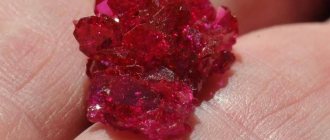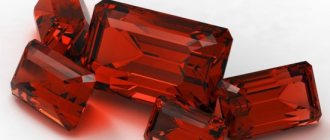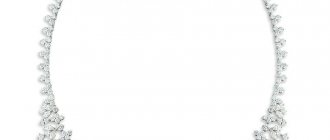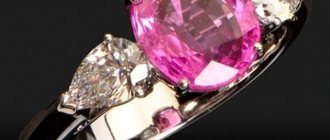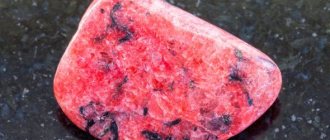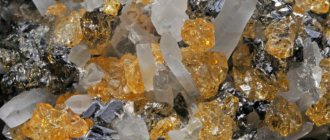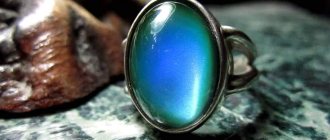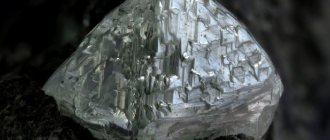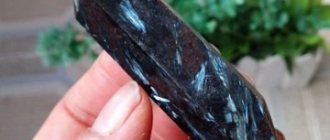The idea that hydrothermal emeralds are some kind of hyped fake made from rhinestones or glass is completely wrong. Modern technologies have made nanocrystals almost perfect.
Hydrothermal stones, created by human hands, act as analogues of real precious gems. Scientists grow stones in special laboratories that do not differ in external characteristics from natural ones.
The advantages of nano-minerals are their similarity to natural stones and their affordable price.
In addition, it is possible to create hydrothermal rocks of any size.
History of the creation of hydrothermal stones
History of the creation of hydrothermal stones:
- Until the 18th century. During these times, many scientists attempted to make jewelry from various minerals and glass.
- 1885-1891. French scientist Auguste Verneuil creates the first synthetic ruby. Later they became known as Geneva rubies. At first he worked with the chemist Edmond Fremy, but after a while he himself developed a method for creating hydrothermal stones using a burner. In 1902 he published the results of his work. The laboratory where these stones were created soon turned into a special production facility. It produced several tons of synthetic rubies. The price of a ruby can be found here.
- 1960-1980. During this period in Russia there was a large surge in popularity for synthetic stones. Jewelry made from 583 gold was often purchased. Sapphires with bright red and bright blue colors. Corundum products have appeared that change color.
Reason for creating hydrothermal sapphires
A natural gemstone with a blue color, rare in nature, is quite expensive, and therefore the issue of developing an analogue has been on the agenda for a long time among jewelers. We can say that, along with the price, the reason for the synthesis of such a mineral is its rare color.
In order to obtain blue shades, dyeing and heating to very high temperatures are used. As a result, there are currently many synthetic stones on the jewelry market, created to meet the high demand for inexpensive blue mineral analogues.
Similarity to natural sapphires
Hydrothermal sapphires
Hydrothermal sapphires are made from corundum. Another name for this method of growing minerals is nanosapphire. (Often on labels you can find the name of the insert “corundum” and depending on the color it will be synthetic sapphire - blue or ruby - red).
Both natural and hydrothermal minerals have the same chemical formula - aluminum oxide - Al2O3 (corundum).
They have the same hardness on the Mohs scale, 9 out of 10 points. Identical properties in terms of the fragility of the mineral, which causes difficulties in its jewelry processing.
What does the name nano sapphire mean?
This is a designation for crystals that exactly replicate a natural gem. Today they are widely used instead of real stones, since nano sapphires have a lower cost. This classification applies to minerals that were grown artificially in the laboratory.
Such stones are extremely difficult to distinguish from natural ones due to their extreme similarity. They have the same hardness, weight, and appearance. The main difference between a nanostone and a fake is that advanced technologies and expensive materials are used for its production.
Technologies for creating artificial gems are constantly evolving. Today, experts create them so similar to natural ones that only an experienced jeweler can find the differences.
How to distinguish natural sapphire from artificial?
In the jewelry market, it is not customary to pass off artificial stones as natural ones. Therefore, when choosing jewelry, you need to be careful and know what is inserted into it - a natural gem or an artificially grown mineral?
The most basic difference lies in the origin of the mineral. Natural, as is obvious from the name itself, is found and extracted from nature (it was formed in difficult conditions over many years). Synthetic or hydrothermal is obtained in the laboratory in a short period of time (grown in 2-3 weeks).
To create a hydrothermal mineral, all the same chemical components are used as in natural minerals, and similar conditions are used - high temperature and pressure.
A mineral grown in laboratory conditions is of higher quality, it does not have impurities that are possible in natural conditions, and also, due to constant monitoring of the process, the crystal is cleaner, without cracks and air bubbles.
Synthetic has a more durable color, unlike natural. It is not affected by UV rays, so it can be worn around the clock.
The difference in price is probably the most important thing. With equal characteristics it will be about 10 times. That is, if a natural sapphire costs $400, its hydrothermal “brother” of the same size will cost only $40.
CRYSTAL GROWING TECHNOLOGY
Hydrothermal technology is a laboratory-based process that replaces the geothermal processes that form emeralds in nature.
Hydrothermal emerald has the same formula and crystal structure as natural emerald.
There is an opinion that minerals can be grown at home, but this is not true. The process of growing crystals is complex and requires the supervision of specialists.
Chromium gives green color
Emerald is a mineral of the beryl group, which contains chromium impurities.
In the laboratory, you can select the optimal amount of chromium to obtain a synthetic emerald of rich green color.
The green color saturation depends on the number of chromium atoms in the crystal lattice of the gem.
We recommend: Noble gems DIAMONDS
How are emeralds grown?
A hydrothermal emerald is created as follows:
- To obtain a high-quality and beautiful crystal, waste from the processing and cutting of natural minerals is used;
- Jewelry dust is additionally crushed and mixed with water;
- The resulting mixture, along with chromium and other components, is placed in a special autoclave, where it is exposed to reagents and temperatures;
- Then, on a special stand, as it cools, a small crystal grows.
It will take 4-5 weeks to get a large artificially grown emerald.
It will take tens of thousands of years for a natural gem to appear in nature.
Features of nano sapphires and nano emeralds
Features of nano emeralds:
- A synthetic emerald weighs much less than a real one. Also, the degree of light refraction is significantly lower.
- These minerals are grown using a hydrothermal process, so when exposed to ultraviolet light they emit a red, luminescent color.
- Synthetic crystals contain feathery inclusions, unlike such elements grown by nature.
- When synthetic stone is processed, it may develop a mirror-like crack that has an irregular shape.
- By using lubrication, the transparency of nano sapphire can be increased.
Features of nano sapphires:
- A softer stone compared to its real counterpart. If you run a stone with a hardness of 8.5 on the Moss scale over the surface of nano sapphire, traces of scratches will remain.
- Do not have any cracks. If there are air bubbles, they have a spherical shape.
- A series of curved stripes with different shades are visible.
- Uneven color and has many different shades.
Ruby imitations and how to identify them
Home Favorites Random article Educational New additions Feedback FAQHaving made sure that the stone being identified is a ruby, we must answer one more important question: is it a natural or synthetic stone, since, as mentioned above, they are almost identical in their physical properties?
Pure, densely colored large rubies are extremely rare in nature. This fact alone should cast doubt on the natural origin of the large pure sample.
In most cases, an experienced expert can simply look at the stone to determine whether it is synthetic. This is due partly to the fact that there is a small but noticeable difference in the nature and proportions of the coloring oxides contained in the stone, but mainly, perhaps, to the fact that synthetic ruby is rarely cut in such a way as to bring out the best color (i.e., to make the most of coloring options). The best color in a ruby is seen in the direction perpendicular to the basal plane of the crystal, which is the direction of its optical axis, i.e. the direction with the only refractive index in which dichroism does not appear. Therefore, a stone that is correctly oriented during cutting does not have dichroism, which can be seen when examining it with a dichroscope directly through the platform. When cutting, a synthetic stone is almost always oriented arbitrarily, based on the shape of the boule, as a result of which the bright purple-red color of the ordinary beam is diluted by the unpleasant yellowish-red color of the extraordinary beam. Both shades are easily observed in a dichroscope when the stone is examined through a platform.
In addition, it must be borne in mind that natural ruby is almost never completely “pure”. It almost always contains inclusions of small crystals of other minerals in the form of pale angular grains, irregularly shaped voids, often of considerable size, and in places thin intersecting channels or thin reddish needles of rutile, which give the stone a silky appearance in reflected light and are known as “silk”. If with the help of a magnifying glass it is possible to detect such inclusions, then we can confidently assume that we are dealing with natural stone. However, one must be careful not to mistake spherical or elongated gas bubbles, which are a characteristic feature of synthetic stones, for crystalline inclusions.” In Burmese ruby, these bubbles rarely reach the size of crystalline inclusions and, under magnification, usually appear as small clouds of dusty particles. Sometimes dense clouds of microscopic bubbles can produce a milky glow that is not like the “silk” in natural stones.
The color distribution in the stone is also a characteristic feature. A curious property of natural Burmese rubies is the presence of spots of darker color in the form of streaks, reminiscent of streams of sugar syrup in water. Even a hint of this feature can serve as a guarantee of the natural origin of the stone. A similar effect is sometimes found in some other chromium-colored stones, such as red spinel, pyrope, and emerald. In synthetic ruby, when examined in the proper position under a loupe or microscope, closely spaced curved lines are always visible, which represent the successive layers of growth of the boule. All these features can be easily and reliably determined with the help of even the simplest microscope, which, moreover, opens up a new interesting and beautiful world to the observer, since the inclusions in most stones, especially ruby, are indeed extremely interesting and worthy of surprise. A great help when studying inclusions in stone can be immersing the sample in a cuvette with a transparent bottom filled with a liquid with a high refractive index, such as monobromonaphthalene. If you are examining a synthetic stone that does not have bubbles, you should look for curved growth lines. To do this, in some cases, the stone must be removed from the setting to examine it from different angles to detect lines, which are usually more noticeable when the lighting is not too bright; in this case, the microscope mirror is tilted to the side and the condenser is lowered.
In Doverneuil synthetics, which are still found in older jewelry, the curved growth lines are much sharper and are not necessarily strictly parallel. Sometimes the stone contains very small inclusions, which an inexperienced person can easily mistake for bubbles. Therefore, in all difficult cases, it is advisable to send the stone for examination to the laboratory.
Among Siamese rubies, very pure stones are sometimes found, but in this case there is a very characteristic lack of fluorescence when irradiated with X-rays and short-wave ultraviolet rays. The most typical types of Siamese rubies are round and opaque inclusions with roughly concentric cracks extending from them. If these inclusions are small, they can be mistaken for the bubbles seen in synthetic stones. Therefore, you need to be very careful when examining. Another feature of Siamese rubies is the presence of twinning planes, which sometimes intersect.
Laboratories also have other research methods that can be used if necessary. For example, under X-rays, both natural and synthetic rubies fluoresce brightly with red light. A similar effect is observed under ultraviolet light or between crossed filters. However, after cessation of irradiation, a noticeable difference is observed between synthetic and natural stones. Almost all natural stones immediately and completely stop glowing, while synthetic rubies give a persistent afterglow, or phosphorescence. To notice this effect, it is necessary to work in the dark and observe the stone with eyes adapted to it. Phosphorescence can also be observed in some natural rubies, but it is very short-lived. Thus, it was found in some low-quality Pakistani rubies, as well as in some Burmese stones with low iron content. Siamese rubies do not have this effect when irradiated with X-rays.
When irradiated with short-wave ultraviolet light, synthetic rubies fluoresce brighter than natural rubies, and although this method should not be relied upon entirely, it can help identify stones among a large batch of small rubies or in jewelry that need special attention in future research. diagnostics.
Also, synthetic rubies are more transparent in short-wave ultraviolet light than natural rubies. This property can be used as a good diagnostic sign in cases where, after examining the stone under a microscope, some doubts still remain.
Everything that has been said so far about synthetic rubies applies to stones produced by the Verneuil method, which has been used in the factories of several large companies for more than 75 years. However, although 99% of synthetic rubies used in jewelry are currently still produced by this inexpensive method, a growing number of synthetic crystal manufacturers have found success in producing synthetic rubies using other methods that produce stones that do not have the well-known features of Verneuil stones. rubies, and therefore more difficult to identify. Most of these stones are obtained by melt growing and therefore contain liquid inclusions such as veils. Professor Chatham often uses natural Burmese rubies as seeds, which, of course, have all the characteristics of these well-known stones. The boundary between the seed and the growing material will be best seen under dark-field illumination under a microscope. Carroll Chatham is now primarily engaged in the production of druzy crystals of ruby and sapphire, and the most difficult to identify individual crystals of synthetic rubies are produced by the Kashan Laboratory in Texas (USA). A typical feature of these stones is the presence of small strips of flux arranged in parallel and similar to long narrow moccasin tracks. You must always remember that in no synthetic stone can you find inclusions of “foreign” minerals, that is, minerals containing elements that are not part of the main mineral.
The only natural stone that resembles the Burmese ruby in color is the red spinel, which is found in the same area. Its color is also due to an admixture of chromium, but the shade of spinel is more brick or orange-red than ruby-red. You can confidently distinguish spinel from ruby by the absence of dichroism and birefringence in spinel, its refractive index (1.72), characteristic absorption spectrum and inclusions. Under a microscope, rubies are clearly distinguishable from spinel in color. In addition, rubies exhibit very strong dichroism when the stones are turned over with tweezers.
Red garnets, with the exception of some pyropes, are closest in color to Siamese ruby and give a very characteristic absorption spectrum with three broad bands in the yellow, green and blue parts of the spectrum. This feature, along with others, ensures their quick and reliable identification.
Tourmaline, the only natural stone to be discussed in this regard, has significantly lower refractive indices (1.62 and 1.64) than ruby and greater birefringence, with strong birefringence allowing an experienced gemologist to see the bifurcation of the edges of the back faces of the stone when observing them across the platform using a magnifying glass.
Imitations made of red glass, usually colored with selenium, have been used less frequently since the introduction of synthetic ruby. A lower refractive index (usually around 1.68), isotropy, lack of dichroism and low hardness all make it possible to distinguish them from ruby. To this day, red doublets are still sometimes found, almost always consisting of a thin almandine plate that serves as the edge of the platform, glued to a red glass base. The pad typically has a refractive index of about 1.79 and the back edges of about 1.63. A careful examination of the stone with a magnifying glass reveals the junction of the parts of the doublet: a thin line is visible crossing the crown just below the platform. This line itself is sometimes not noticeable, but the sharp change in brilliance as it transitions from garnet to glass in a doublet is noticeable when looking at the stone at the proper angle. Although the garnet lamina is very thin, the absorption bands of almandine can usually be detected in a spectroscope when light passes through the stone. It is not difficult to identify a fake if a stone immersed in liquid is viewed from the side against a white background. It is best to use a liquid with a high refractive index, such as monobromonaphthalene. Under a microscope in a doublet, if you look at it through the platform, needle-shaped crystalline inclusions can be visible in the almandine layer, and behind them there can be air bubbles both in the layer of glue connecting the parts of the doublet and in the glass substrate.
Witty doublets of modern production pose a great danger. In these doublets, a thin slab of low-quality natural Australian sapphire is glued to a base of synthetic ruby or sapphire and then cut so that the joint line runs exactly along the girdle of the finished stone. When such a doublet is mounted in a setting, it looks like a real natural stone, since the “vulgarity” of the color of the Verneuil synthetic ruby is softened when light passes through the sapphire crown, which has the “silk” and other natural inclusions characteristic of corundum. There are known cases of successful deception using such doublets, specially made for fraudulent purposes. The best defense against deception is constant vigilance. If suspicion arises, it is necessary to check the stone for a number of parameters (for example, determine the presence of red fluorescence at the base of such composite stones when they are irradiated with ultraviolet light) and use the obtained data as evidence.
A list of red stones that are similar in appearance to ruby: zircon, almandine, pyrope, spinel, topaz and tourmaline.
Zircon is included for completeness, although red zircon is not the same shade as ruby. Topaz is also listed because this deep pink colored stone can be mistaken for a pale Ceylon ruby known as a “pink sapphire.” Almandine can only be mistaken for a Siamese ruby. Although the dichroism of the latter is sometimes quite weak, distinguishing this ruby from almandine is not difficult if you carefully measure the refractive index in the light of a sodium lamp. In this case, the ruby will have a clearly visible birefringence. Garnet can also be easily recognized by its absorption spectrum.
Lecture 5. Sapphire (1 hour).
1. Physical, optical and morphological properties of sapphire and methods for their determination.
Previous12Next
Diffusion and declassed sapphire
Diffusion is a chemical and physical process of penetration of molecules of a substance into the molecules of another substance. Diffusion is used as a method for refining precious stones, including for refining fancy types of sapphire.
Fancy sapphire - any type except blue.
In order to refine star sapphire, diffusion with beryllium salts is used. As a result of heating and creating high pressure, beryllium salts penetrate into it in such a way that they “impregnate” the stone through and through. The effect of asterism is noticeably enhanced.
Methods for diffusion refining of sapphires can be of two main types: “impregnation” of the outer layer of corundum, when the true color becomes invisible underneath it, and “internal” diffusion, when at high temperatures internal inclusions in corundum, such as titanium and chromium, dissolve and coloring occurs mineral.
In any case, the refinement of corundum by diffusion methods is legal, if after this the gem is not presented as natural, but it is honestly indicated that these manipulations were carried out with it. Otherwise, it will be misleading or deceiving the consumer.
Declassed should not be confused with diffusion or synthetic. This gem is natural, but of low quality. So, it is cloudy and/or opaque. Quality characteristics, of course, affect its price, although it may be more expensive than synthetic ones. The label usually says “decl,” which means “declassed.”
WHAT ARE SUCH STONES NEEDED FOR?
The need to create artificial stones is determined by a number of reasons:
- Jewelry with natural stones is expensive: jewelry with hydrothermal emeralds is just as beautiful, but costs 70 times more.
- The processes of prospecting and mining of precious gems are labor-intensive and resource-intensive, while creating artificial stones in the laboratory is much simpler and cheaper.
- Natural resources are being depleted, and it is becoming more difficult to find deposits with new reserves of minerals.
- Artificially grown stones are used by jewelers of world fashion houses.
Magical and healing properties
Theoretically, artificially grown emerald crystals should have similar magical properties as natural ones. After all, a man-made mineral is created from similar components under the influence of similar processes.
Nano-emeralds are used for the same magical rituals as natural ones: for example, they disinfect water by placing the mineral in the liquid for 24 hours.
Medicinal qualities
These stones are also used for medicinal purposes.
For people
It is useful to have green gem jewelry:
- people suffering from heart disease,
- people susceptible to stress and respiratory problems.
For indoors
It is believed that if you store a green gem in your home, you can:
- protect yourself from bad energy;
- gain family well-being;
- get rid of attacks of anger;
- fill the house with love.
Green gems look good when set in rhodium-plated silver, platinum or white gold.
The frame emphasizes the beauty of emeralds, and the metal enhances the effect of the stone.
Can it be used as talismans?
Even an artificially grown gem has a certain energy.
We recommend: What is the difference between a DIAMOND and a DIAMOND
Hydrothermal emeralds are used in the manufacture of talismans for the same reason as natural minerals: because raw materials from natural emeralds are used to create artificial gems.
Talismans made from green minerals help the owner in the following matters:
- will protect from damage with the evil eye;
- sailors will be protected from storms and storms;
- will organize your thoughts and calm you down.
Who is suitable according to Horoscope
The energy of crystals is not suitable for all zodiac signs:
- wearing hydrothermal jewelry is not recommended for SCORPIO;
- ARIES ensure success in business;
- TAURUS strengthens memory;
- GEMINI discover talents;
- CANCER and LIBRA help to find peace of mind;
- LIONS increase vital energy;
- CAPRICORN and SAGITTARIUS are relieved of mental anxieties, but these signs should not abuse the mineral;
- for PISCES and AQUARIUS it is a strong talisman that brings happiness and success.
Artificial sapphire - what to look for when choosing?
If you decide to purchase jewelry with just such an insert, then all that remains is to decide on the color and cut. The artistic component will play a big role in the price, so the choice should be based primarily on it.
The most expensive are the types of cutting of transparent stones, which reveal their beauty and make you admire the play of light created by the faces. In jewelry stores, it is not customary to pass off any other materials as hydrothermal. In workshops that make expensive jewelry to order - even more so.
And of course, you should not buy jewelry second-hand or in dubious places, where instead of synthetic (not to mention natural) minerals they can sell inserts made of glass or a similar material.
Designations on jewelry tags
First of all, we note that the designations on jewelry tags refer to precious stones of natural origin. The first number indicates the number of stones in the product, 1, 2, etc. Then the name of the stone is abbreviated. For example, Sp. means sapphire and that the stone is natural, natural. Sp.ob. – means diffusion or ennobled.
Also indicating Sp. cor. – that is, corundum, which means that the product contains a hydrothermal mineral. Next, the tag indicates the shape of the cut - for example, Gr - pear, Kv - square, Tk - triangle. Then there are the digital characteristics of the gemstone - weight, color, clarity.
Hydrothermal, like all synthetic minerals, do not (and cannot have) the digital characteristics of color and purity on jewelry tags that are inherent in natural ones!
Red stone family
In jewelry, minerals such as noble spinel, red and pink tourmaline and garnet are used as a substitute for rare gems - red corundum rubies.
The easiest way to spot a fake is with garnet. Unlike the “stone of stones”, its luster is much weaker.
Garnet is a stone of a different shade of red, with a bias away from purple; it matches the color rather of old red wine.
It is softer - up to 7.5 Mohs, has a different shape of the crystal lattice and a resinous, rather than glass-diamond, luster. In the sun it shines matte, while red corundum shines brightly.
Garnet can be recognized by its property of magnetization, which is absent in ruby.
Tourmaline also has a high affinity for ruby, especially the inexpensive light red and pink ones. It has a rich pink color and a similar glassy sheen. When checking gems, tourmalines are screened out when exposed to an ultraviolet lamp. Ultraviolet light, passing through tourmaline or another scarlet crystal, gives an orange glow; passing through a ruby, it remains red.
Silver earrings with emerald, tourmaline and ruby
In the same way, you can distinguish a true ruby from a synthetic one.
It is most difficult to distinguish a fake if it is a noble red spinel.
You cannot do this on your own, since spinel has similar properties; the difference with ruby is extremely small. If you suspect a spinel, you can check the authenticity of a stone only in a jewelry laboratory.
Gold ring ruby and spinel
Spinel crystals have a strawberry hue, but some varieties of rubies also have the same color.
If you doubt the originality of a stone, especially if it is framed with precious metals, it is best to contact a jewelry workshop or local office of the Assay Office.
The healing properties of nano sapphires and nano emeralds
The healing properties of nano sapphire:
- Sapphire is credited with properties such as treating heart and kidney failure.
- It helps with asthma as well as urinary problems.
- Against the background of a general strengthening of the body's immunity, sapphire treats the human nervous system and eliminates diseases of internal organs.
Healing properties of nano emerald:
- Emerald treats inflammation, protects against various infections, can reduce temperature during illnesses, and removes toxins from the body.
- This stone treats burns and diabetes, arrhythmia, reduces blood pressure and helps in the treatment of psoriasis.
- Emerald heals the liver, stomach and other organs.
- Its healing properties are also important for insomnia.
- Helps in such serious diseases as tuberculosis and asthma.
- Pleasant color also has a positive effect on eye function.
